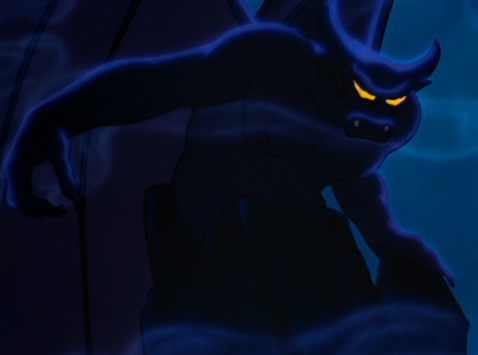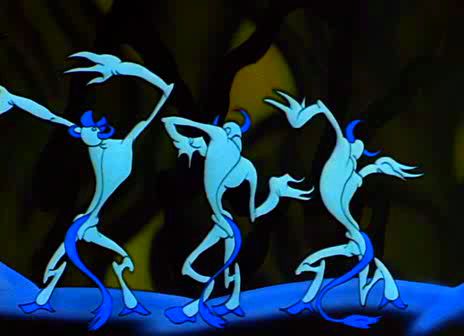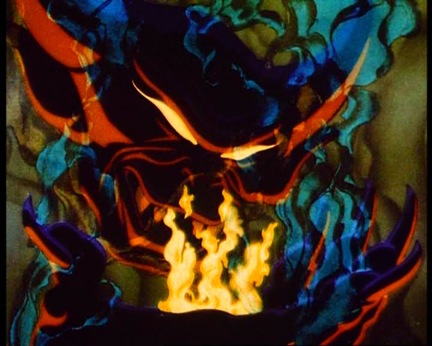*note: I’m only covering the “Night on Bald Mountain” segment, not the “Ave Maria” that follows

When I originally conceived of the Disturbing Disney series, I always planned on including Night on Bald Mountain from the finale of Fantasia (1940). It is well known that this segment is considered to be one of the darkest pieces of animation that Disney ever produced. But, and this might surprise you, it is also one of the few “disturbing” pieces that didn’t scare me as a child.
Let me explain: if you haven’t seen the original Fantasia film, Night on Bald Mountain is based on the symphonic poem of the same name (and earlier referred to as St. John’s Eve on Bald Mountain) by Modest Mussorgsky, with an arrangement created by his friend Nikolay Rimsky-Korsakov. The segment takes place one night in an unnamed country village surrounded by mountains. The highest peak is revealed to actually be the massive body of Chernabog, a terrifyingly huge black winged demon, who uses his evil powers to summon all the dead spirits, witches and other lesser demons to attend him and perform for his pleasure. After wreaking havoc all night long, Chernabog goes toward the village itself, only to be stopped by the distant church bells chiming for Matins, signalling the arrival of dawn, and the end of Chernabog’s power for the night.
As I mentioned earlier, Night on Bald Mountain did not scare me as a child. I thought long and hard about it, trying to remember how I felt watching Chernabog reveal himself, but I cannot find a single memory where I quivered in terror. If anything, I was almost in awe of what I was seeing. I mean just look at the creature below:

Chernabog is rightly considered a masterpiece of Disney animation. He’s a perfect example of the intensive labor that went into Golden Age Disney animation. In the opening minute, when Chernabog shrugs his wings open, you can feel the weight behind the motion, even though he’s nothing more than a drawing on the screen.
Now, on to the disturbing elements of this piece (and they are many). First of all, as I said before, this is considered to be one of the darkest (if not THE darkest) animations that Disney ever produced, because never before has such raw evil been depicted. In fact, in the earliest stages, Chernabog was intended to be Satan himself (and referred to as such) but such a blatant religious statement was deemed….unwise (that’s my assumption anyway). Even though he’s named differently, it’s not hard to view Chernabog as the Devil (he’s got horns, wings, big glowing eyes, if he were red instead of black he’d be a perfect likeness to traditional images of Satan).

Aside from being pure evil, what also makes Chernabog himself disturbing is his sheer size: he’s so large that his wings are viewed as a literal mountain top! Full size humans (I would assume) could stand on his palm with plenty of room to spare. Not that you would WANT to of course, at one point, the demon creates fire dancers that dance on his palms before being cruelly twisted into barnyard animals and finally morphed into blue demons that frantically dance to please their master.

Other disturbing elements include the various ghouls and skeletons that fly through the air when summoned. There are skeletons riding skeletal horses (a reference to the Danse Macabre), ghouls with glowing eyes, witches on brooms and other strange figures. By the final chaotic minutes of the piece, the disturbing factor is ramped up: there are harpies flying straight up to the screen (revealing they were topless in a blink-and-you’ll-miss-it moment), skulls and weird masks, all moving in a frantic blur.
Funnily enough, even though Fantasia was released almost 80 years ago, Disney still receives complaints from parents of children traumatized by this particular segment. If you have young children, I would definitely be wary of letting them see this segment too soon, but don’t hide it forever either.
And that’s just a glimpse of my thoughts on Chernabog and Night on Bald Mountain, I hope you enjoy watching the segment in the above link. Let me know YOUR thoughts in the comments below.
For more Disturbing Disney, check out the main page here
See also:
Disturbing Disney #1: The Coachman in Pinocchio (1940)
Disturbing Disney #2: The truth of Pleasure Island in Pinocchio (1940)
Disturbing Disney #3: Escaping Monstro from Pinocchio (1940)
Disturbing Disney #4: Dumbo loses his mother (1941)
Disturbing Disney #5 The death of Bambi’s Mother
Disturbing Disney #6: Faline vs. the dogs (1942)
Disturbing Disney #7: Cruella wants to do WHAT??
Disturbing Disney #8: The Whale Who Wanted to Sing at the Met (from Make Mine Music, 1946)
Disturbing Disney #9: Dr. Facilier’s Fate (The Princess and the Frog, 2009)
Disturbing Disney #10: The rat in Lady and the Tramp (1955)
Disturbing Disney #11: Clayton’s Death in Tarzan (1999)
Disturbing Disney #12: The Bear from The Fox and the Hound (1981)
Disturbing Disney #13: “Smoking them out” in The Fox and the Hound (1981)
Disturbing Disney #14: The Salt Trap in The Jungle Book (1994)
Disturbing Disney #16: King Triton destroys Ariel’s grotto
Disturbing Disney #17: Ratigan becomes a monster in The Great Mouse Detective
Disturbing Disney #18: The Queen’s assignment for her Huntsman
Disturbing Disney #19: Cinderella’s dress is destroyed (1950)
Disturbing Disney #20: Quasimodo is crowned ‘King of Fools’ (1996)
Don’t forget to like Film Music Central on Facebook 🙂


The great Bela Lugosi pantomimed the movements for the demon Chernabog, according to n o less an authority than Walt Disney himself!
LikeLiked by 1 person
this is true, but the animator for Chernabog, Vladimir Tytla, was unsatisfied with Lugosi’s work so he drafted the director of Night on Bald Mountain Wilfred Jackson to pose instead, and it’s the latter work that influenced the character
LikeLiked by 1 person
Scary is good. Terrifying is bad. Disney stubs its toe creatively when it does the latter.
LikeLike
Pingback: Disturbing Disney #2: The truth of Pleasure Island in Pinocchio (1940) | Film Music Central
Pingback: Disturbing Disney #3: Escaping Monstro from Pinocchio (1940) | Film Music Central
Pingback: Disturbing Disney #1: The Coachman in Pinocchio (1940) | Film Music Central
Pingback: Disturbing Disney #11: Clayton’s Death in Tarzan (1999) | Film Music Central
Pingback: Disturbing Disney #14: The Salt Trap in The Jungle Book (1994) | Film Music Central
Pingback: Disturbing Disney #7: Cruella wants to do WHAT?? | Film Music Central
Pingback: Disturbing Disney #5: The death of Bambi’s Mother (1942) | Film Music Central
Pingback: Disturbing Disney #6: Faline vs. the dogs (1942) | Film Music Central
Pingback: Disturbing Disney #9: Dr. Facilier’s Fate (The Princess and the Frog, 2009) | Film Music Central
Pingback: Disturbing Disney #10: The rat in Lady and the Tramp (1955) | Film Music Central
Pingback: Disturbing Disney #13: “Smoking them out” in The Fox and the Hound (1981) | Film Music Central
Pingback: Disturbing Disney #12: The Bear from The Fox and the Hound (1981) | Film Music Central
Pingback: Disturbing Disney #16: King Triton destroys Ariel’s grotto | Film Music Central
Pingback: Disturbing Disney #4: Dumbo loses his mother (1941) | Film Music Central
Pingback: Disturbing Disney #17: Ratigan becomes a monster | Film Music Central
Pingback: Disturbing Disney #8: The Whale Who Wanted to Sing at the Met (from Make Mine Music, 1946) | Film Music Central
Pingback: Disturbing Disney #18: The Queen’s assignment for her Huntsman | Film Music Central
He was the inspiration for the Balrog in Lord of the Rings. Tolkien historians believe that bc right after Tolkien saw Fantasia, he wrote that part and he had been stuck for a year on that.
LikeLiked by 1 person
Really?? That is so cool, I’d never heard that before! Now that you mention it I can see the resemblance between the two
LikeLike
I wish this could let me photograph the page, but: “Of course Tolkien wasn’t just trying to resonate with Shakespeare. He drew on other sources, some of them that were quite modern. Tolkien wrote The Lord of the Rings over a period of about 13 years, and he writes that in 1939 he ground to a halt at Balin’s tomb. He says that it was “over a year later in 1941 that I moved on.” Now Fantasia was released in 1940, and I doubt that you had to think about it long before you recognize the resemblance of the Balrog in the Lord of the rings has to the demon from “Night on Bald Mountain”
Drawing on the Power of Resonance in Writing by David Farland
LikeLiked by 1 person
Pingback: Disturbing Disney #19: Cinderella’s dress is destroyed (1950) | Film Music Central
Pingback: Disturbing Disney #20: Quasimodo is crowned ‘King of Fools’ (1996) | Film Music Central
I would suggest that Night on Bald Mountain is actually scarier for adults than for chilren because they’re more likely to understand it. Children just see one big monster and lots of little ones, plus some flames, and they’re mostly dancing which reduces the scariness.
LikeLiked by 1 person
hmmmm, I hadn’t thought about it like that. I still think that Chernabog himself can be scary for children that are small enough
LikeLike
Pingback: These Disney 'Failures' Prove Your Idea of Success May Be Wrong
Pingback: Walt Disney Movie Failures - mr880's health, wealth and life
Pingback: These Disney ‘Failures’ Prove Your Idea of Success May Be Wrong - Success Gazette
Pingback: “On Leather Wings": Watching Animated Batman 30 Years Late